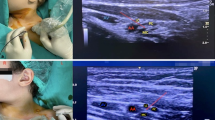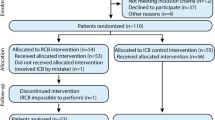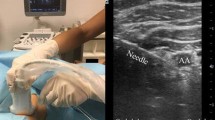Abstract
Purpose
Costoclavicular brachial plexus block has been described recently as a new technique in adults and pediatric patients. In this study, we aimed to compare the supraclavicular and costoclavicular approaches, which are claimed to be effective and practical in pediatric patients.
Methods
Sixty children were randomized to receive supraclavicular (SC group) or costoclavicular (CC group) brachial plexus blocks prior to surgical incision. Block performance times were recorded as the primary outcome. Procedural features (ideal brachial plexus cord visualization/needle pathway planning time, needle tip/shaft visualization difficulty, number of needle maneuvers, requirement of extra needle maneuvers due to insufficient local anesthetic distribution) and postoperative pain-related data (sensorimotor block intensities, Wong-Baker and FLACC pain scores and analgesic requirements) were also evaluated. To observe the tendency toward respiratory complications, ultrasonographic diaphragm movement amplitude (with M-mode) and diaphragm thickness (with B-mode) were measured postoperatively.
Results
A total of 56 patients were included. Block performance times [70(7–97) vs. 115(75–180) s] were significantly lower in the CC group (p < 0.01). The block success rates did not differ (p > 0.05). The incidence of hemidiaphragm paralysis was 44% in the SC group (p < 0.001), and inspiratory diaphragm thickness was significantly lower (p < 0.01). None of CC group patients experienced hemidiaphragm paralysis. All other parameters were comparable (p > 0.05).
Conclusions
Although costoclavicular block did not show superiority in pain management, the block performance was perceived as more practical than supraclavicular block. We believe that costoclavicular brachial plexus block stands as a good option in upper extremity surgeries with the advantages of shorter block performance time and reduced ipsilateral hemidiaphragm paralysis risk in pediatric patients.





Similar content being viewed by others
Data availability
The data set used and/or analysed during the current study available from the corresponding author on reasonable request.
Change history
17 December 2022
A Correction to this paper has been published: https://doi.org/10.1007/s00540-022-03152-6
References
Landry BW, Fischer PR, Driscoll SW, Koch KM, Harbeck-Weber C, Mack KJ, Wilder RT, Bauer BA, Brandenburg JE. Managing chronic pain in children and adolescents: a clinical review. PM R. 2015;7:295–315.
Wick EC, Grant MC, Wu CL. Postoperative multimodal analgesia pain management with nonopioid analgesics and techniques: a review. JAMA Surg. 2017;152:691–7.
De Jose MB, Banus E, Navarro Egea M, Serrano S, Perello M, Mabrok M. Ultrasound-guided supraclavicular vs infraclavicular brachial plexus blocks in children. Paediatr Anaesth. 2008;18:838–44.
Koyyalamudi V, Langley NR, Harbell MW, Kraus MB, Craner RC, Seamans DP. Evaluating the spread of costoclavicular brachial plexus block: an anatomical study. Reg Anesth Pain Med. 2021;46:31–4.
Karmakar MK, Sala-Blanch X, Songthamwat B, Tsui BC. Benefits of the costoclavicular space for ultrasound-guided infraclavicular brachial plexus block: description of a costoclavicular approach. Reg Anesth Pain Med. 2015;40:287–8.
Layera S, Aliste J, Bravo D, Fernandez D, Garcia A, Finlayson RJ, Tran DQ. Single versus double injection costoclavicular block. Reg Anesth Pain Med. 2020;45:209–13.
Dhir S, Brown B, Mack P, Bureau Y, Yu J, Ross D. Infraclavicular and supraclavicular approaches to brachial plexus for ambulatory elbow surgery: a randomized controlled observer-blinded trial. J Clin Anesth. 2018;48:67–72.
Yeh L, Montealegre-Gallegos M, Mahmood F, Hess PE, Shnider M, Mitchell JD, Jones SB, Mashari A, Wong V, Matyal R. Assessment of perioperative ultrasound workflow understanding: a consensus. J Cardiothorac Vasc Anesth. 2017;31:197–202.
Birnie KA, Hundert AS, Lalloo C, Nguyen C, Stinson JN. Recommendations for selection of self-report pain intensity measures in children and adolescents: a systematic review and quality assessment of measurement properties. Pain. 2019;160:5–18.
Hong B, Lee S, Oh C, Park S, Rhim H, Jeong K, Chung W, Lee S, Lim C, Shin YS. Hemidiaphragmatic paralysis following costoclavicular versus supraclavicular brachial plexus block: a randomized controlled trial. Sci Rep. 2021;11:20602.
Yayik AM, Cesur S, Ozturk F, Celik EC, Naldan ME, Ahiskalioglu A. Comparison of the lateral sagittal and costoclavicular approaches for ultrasound-guided infraclavicular block in pediatric patients: a prospective randomized study. Braz J Anesthesiol. 2021. https://doi.org/10.1016/j.bjane.2021.05.005.
Luo Q, Yao W, Chai Y, Chang L, Yao H, Liang J, Hao N, Guo S, Shu H. Comparison of ultrasound-guided supraclavicular and costoclavicular brachial plexus block using a modified double-injection technique: a randomized non-inferiority trial. 2020. Biosci Rep. https://doi.org/10.1042/BSR20200084.
Li JW, Songthamwat B, Samy W, Sala-Blanch X, Karmakar MK. Ultrasound-guided costoclavicular brachial plexus block: sonoanatomy, technique, and block dynamics. Reg Anesth Pain Med. 2017;42:233–40.
Songthamwat B, Karmakar MK, Li JW, Samy W, Mok LYH. Ultrasound-guided infraclavicular brachial plexus block: prospective randomized comparison of the lateral sagittal and costoclavicular approach. Reg Anesth Pain Med. 2018;43:825–31.
Zhang L, Pang R, Zhang L. Comparison of ultrasound-guided costoclavicular and supraclavicular brachial plexus block for upper extremity surgery: a propensity score matched retrospective cohort study. Ann Palliat Med. 2021;10:454–61.
Ferre F, Mastantuono JM, Martin C, Ferrier A, Marty P, Laumonerie P, Bonnevialle N, Minville V. Hemidiaphragmatic paralysis after ultrasound-guided supraclavicular block: a prospective cohort study. Braz J Anesthesiol. 2019;69:580–6.
Oh C, Noh C, Eom H, Lee S, Park S, Lee S, Shin YS, Ko Y, Chung W, Hong B. Costoclavicular brachial plexus block reduces hemidiaphragmatic paralysis more than supraclavicular brachial plexus block: retrospective, propensity score matched cohort study. Korean J Pain. 2020;33:144–52.
Sivashanmugam T, Maurya I, Kumar N, Karmakar MK. Ipsilateral hemidiaphragmatic paresis after a supraclavicular and costoclavicular brachial plexus block: a randomised observer blinded study. Eur J Anaesthesiol. 2019;36:787–95.
Aliste J, Bravo D, Layera S, Fernandez D, Jara A, Maccioni C, Infante C, Finlayson RJ, Tran DQ. Randomized comparison between interscalene and costoclavicular blocks for arthroscopic shoulder surgery. Reg Anesth Pain Med. 2019. https://doi.org/10.1136/rapm-2018-100055.
Miao Y, Zhang H. Ipsilateral hemidiaphragmatic paresis after a supraclavicular and costoclavicular brachial plexus block. Eur J Anaesthesiol. 2020;37:416–7.
Acknowledgements
We would like to thank Dr. Zerrin Sungur for randomization setup and preparation and Dr. Omer Berkoz for the surgical care of the patients.
Author information
Authors and Affiliations
Corresponding author
Ethics declarations
Conflict of interest
None.
Additional information
Publisher's Note
Springer Nature remains neutral with regard to jurisdictional claims in published maps and institutional affiliations.
About this article
Cite this article
Guzel, M., Bingul, E.S., Salviz, E.A. et al. Comparison of ultrasound-guided supraclavicular and costoclavicular brachial plexus blocks in pediatric patients: a randomized clinical trial. J Anesth 37, 186–194 (2023). https://doi.org/10.1007/s00540-022-03143-7
Received:
Accepted:
Published:
Issue Date:
DOI: https://doi.org/10.1007/s00540-022-03143-7




